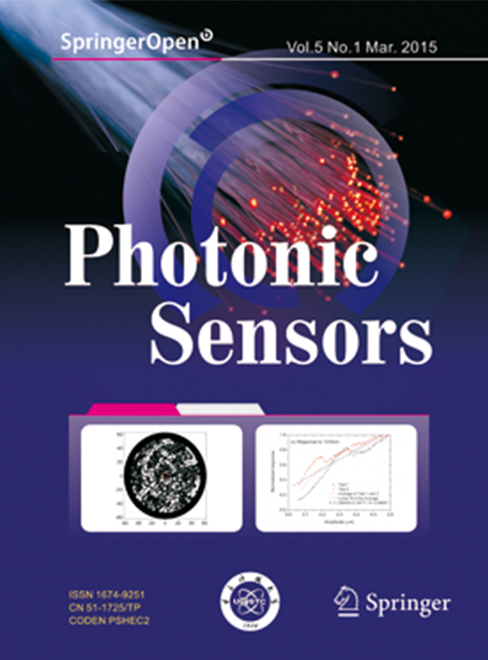 View fulltext
View fulltext
With micro- and nano-structured optical fibers, parts-per-million to parts-per-trillion level gas detection has been demonstrated for a range of gases such as methane, acetylene, ethane, carbon monoxide, hydrogen, and oxygen. We review the recent development in optical fiber gas cells and gas detection systems based on direct absorption, photothermal, photoacoustic, and stimulated Raman spectroscopies.
Optical fiber sensing technology has developed rapidly since the 1980s with the development of the optical fiber and fiber optical communication technology. It is a new type of sensing technology that uses light as a carrier and optical fiber as a medium to sense and transmit external signals (measurands). Distributed fiber optical sensors (DFOS) can continuously measure the external physical parameters distributed along the geometric path of the optical fiber. Meanwhile, the spatial distribution and change information of the measured physical parameters over time can be obtained. This technology has unmatched advantages over traditional point-wise and electrical measurement monitoring technologies. This paper summarizes the state-of-the-art research of the application of the distributed optical fiber sensing technology in geo-engineering in the past 10 years, mainly including the advantages of DFOS, the challenges in geo-engineering monitoring, related fundamental theoretical issues, sensing performance of the optical sensing cables, distributed optical fiber monitoring system for geo-engineering, and applications of optical fiber sensing technology in geo-engineering.
Accurate spectral measurement and wavelength determination are fundamental and vital for many fields. A compact spectrum analyzer with high performance is expected to meet the growing requirements, and speckle-based spectrum analyzer is a potential solution. The basic principle is based on using the random medium to establish a speckle-to-wavelength mapping relationship for spectrum reconstruction. This article introduces current speckle-based spectrum analyzers with different schemes and reviews recent advances in this field. Besides, some applications by using speckle-based spectrum analyzers are also introduced. Finally, the existing challenges and the future prospects of using speckle for spectrum recovery are discussed.
Fiber Bragg grating (FBG) is the most widely used optical fiber sensor due to its compact size, high sensitivity, and easiness for multiplexing. Conventional FBGs fabricated by using an ultraviolet (UV) laser phase-mask method require the sensitization of the optical fiber and could not be used at high temperatures. Recently, the fabrication of FBGs by using a femtosecond laser has attracted extensive interests due to its excellent flexibility in creating FBGs array or special FBGs with complex spectra. The femtosecond laser could also be used for inscribing various FBGs on almost all fiber types, even fibers without any photosensitivity. Such femtosecond-laser-induced FBGs exhibit excellent thermal stability, which is suitable for sensing in harsh environment. In this review, we present the historical developments and recent advances in the fabrication technologies and sensing applications of femtosecond-laser-inscribed FBGs. Firstly, the mechanism of femtosecond-laser-induced material modification is introduced. And then, three different fabrication technologies, i.e., femtosecond laser phase mask technology, femtosecond laser holographic interferometry, and femtosecond laser direct writing technology, are discussed. Finally, the advances in high-temperature sensing applications and vector bending sensing applications of various femtosecond-laser-inscribed FBGs are summarized. Such femtosecond-laser-inscribed FBGs are promising in many industrial areas, such as aerospace vehicles, nuclear plants, oil and gas explorations, and advanced robotics in harsh environments.
This paper reviews a wide variety of fiber-optic microstructure (FOM) sensors, such as fiber Bragg grating (FBG) sensors, long-period fiber grating (LPFG) sensors, Fabry-Perot interferometer (FPI) sensors, Mach-Zehnder interferometer (MZI) sensors, Michelson interferometer (MI) sensors, and Sagnac interferometer (SI) sensors. Each FOM sensor has been introduced in the terms of structure types, fabrication methods, and their sensing applications. In addition, the sensing characteristics of different structures under the same type of FOM sensor are compared, and the sensing characteristics of the all FOM sensors, including advantages, disadvantages, and main sensing parameters, are summarized. We also discuss the future development of FOM sensors.
Fiber optofluidic laser (FOFL) integrates optical fiber microcavity and microfluidic channel and provides many unique advantages for sensing applications. FOFLs not only inherit the advantages of lasers such as high sensitivity, high signal-to-noise ratio, and narrow linewidth, but also hold the unique features of optical fiber, including ease of integration, high repeatability, and low cost. With the development of new fiber structures and fabrication technologies, FOFLs become an important branch of optical fiber sensors, especially for application in biochemical detection. In this paper, the recent progress on FOFL is reviewed. We focuse mainly on the optical fiber resonators, gain medium, and the emerging sensing applications. The prospects for FOFL are also discussed. We believe that the FOFL sensor provides a promising technology for biomedical analysis and environmental monitoring.









